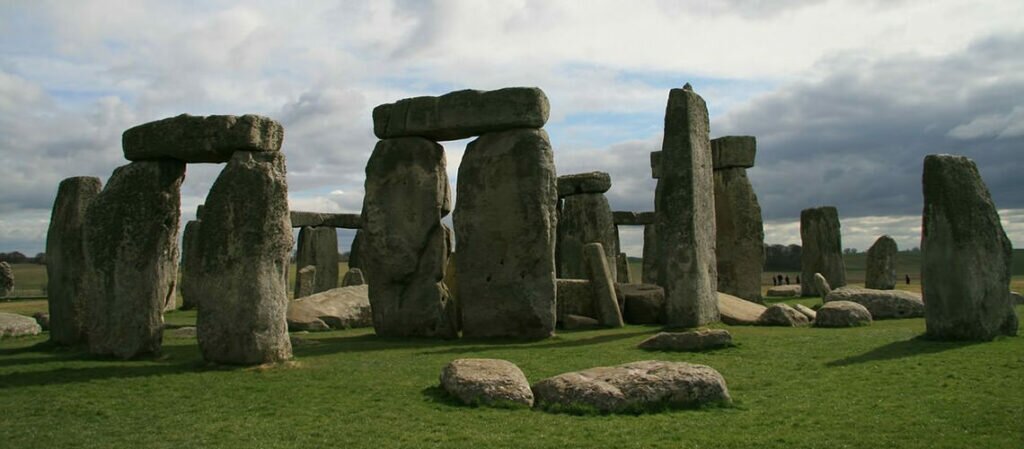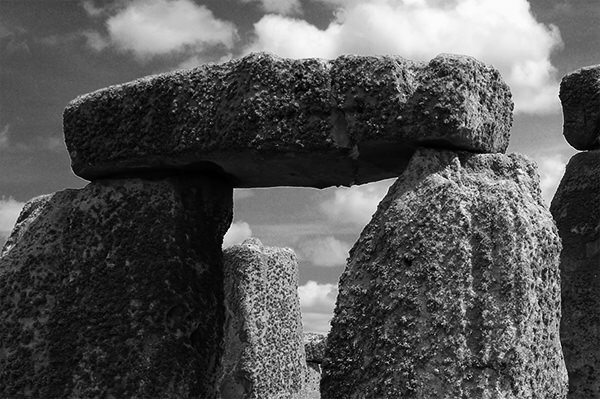
A History In Numbers
The wider area within which Stonehenge sits features an unusually large number of earthworks, long barrows and other monuments, dating back as far as 8500 BC. Stonehenge was initially a simpler monument built around 3000 BC which comprised of a circular ditch dug into the earth, with an inner and outer bank. Inside the inner bank were 56 chalk pits.
Around 2,500 BC, the stones arrived. These were set up as a horseshoe of large sarsen trilithons contained within a circle of sarsen stones. Also inside that stone circle were placed a number of smaller bluestones, arranged in a double arc shape. An altar stone was placed inside the horseshoe. A single heel stone was also placed outside the main entrance to the outer ditch.
Then, sometime around 2,200 BC, the bluestones were repositioned to form a complete circle around the horseshoe, so the sarsen horseshoe was now inside an inner bluestone circle and an outer sarsen stone circle. Additionally, some of the bluestones were laid out in an oval within the horseshoe. Still later (date unknown), this oval was reformed into a horseshoe shape as well.
10 Stonehenge Facts

Before Stonehenge
20,000 tons – the estimated amount of chalk dug out to create the Greater Cursus, a causeway enclosure created as much as 500 years before the first Stonehenge monument.
+ Read more about the period before Stonehenge
Stonehenge history
64 – the approximate number of human cremations that have been found at Stonehenge.
+ Read more about the history of Stonehenge
After Stonehenge
31 December 1900 – the date on which one of the uprights of the sarsen stone circle fell over, leading to public pressure to start a major restoration project.
+ Read more about Stonehenge in the Victorian era
Stonehenge today
1,000,000+ – the number of visitors the Stonehenge monument receives each year.
+ Read more about Stonehenge today
Stonehenge timeline
c 2500 BC – approximate point that both the stone monument at Stonehenge and the Great Pyramid in Egypt appeared.
+ See the complete timeline of Stonehenge
How Stonehenge was built
10 years – the estimated time it would have taken to drag all of the sarsen stones to the monument site.
+ Read more about how they built Stonehenge
Who built Stonehenge
4,000 – the approximate number of people who lived at the Durrington Walls encampment, believed to be the people who built the stone monument.
+ Read more the people who built Stonehenge
The size of the stones
9 m – the approximate length of the tallest stone still standing.
+ Read more about the different sizes of the stones
The number of stones
160 – the approximate number of stones required to build Stonehenge.
+ Read more about the number of stones now and then
The Aubrey Holes
56 – the number of chalk pits (the Aubrey Holes) discovered inside the earth bank of Stonehenge.
+ Read more about the Aubrey Holes
Phases of Stonehenge
3000-2920 BC – Stage 1: the earth bank and ditch are built, and the 56 ‘Aubrey Holes’ dug.
2620-2480 BC – Stage 2: the stones arrive – the sarsen stone circle, bluestone circle, and the 5 trilithons.
2480-2280 BC – Stage 3: the Q and R holes appear, the Avenue is built, and the bluestones are rearranged.
2280-2020 BC – Stage 4: the bluestones are rearranged into an oval shape, and then still later into a circle.
1680-1520 BC – Stage 5: the Y and Z holes appear.
Some Useful Definitions
Neolithic – meaning New Stone Age, a period that followed on from the Palaeolithic (Old Stone Age) and the Mesolithic (Middle Stone Age). The people of the Neolithic era used stone tools, made pottery, grew crops and kept domestic animals.
Henge – an enclosure, commonly circular in shape, which has an outer bank and an inner ditch.
Sarsen – derived from “Saracen stone”, Saracen being a name from the Wiltshire dialect which referred to anything considered to be non-Christian (Pagan, Celtic or Muslim).
Bluestone – in general use ‘bluestone’ is the common name for one type of rock, spotted dolerite. However, in the context of Stonehenge, ‘bluestone’ is an informal name used to group all of the smaller stones that are foreign to the area (including spotted dolerites, dolerites, volcanic tuffs, and rhyolites).
Solstice – the longest and shortest days of the year, occurring at midsummer and midwinter.
Equinox – the days of the year on which day and night are exactly the same length, occurring in spring and autumn.